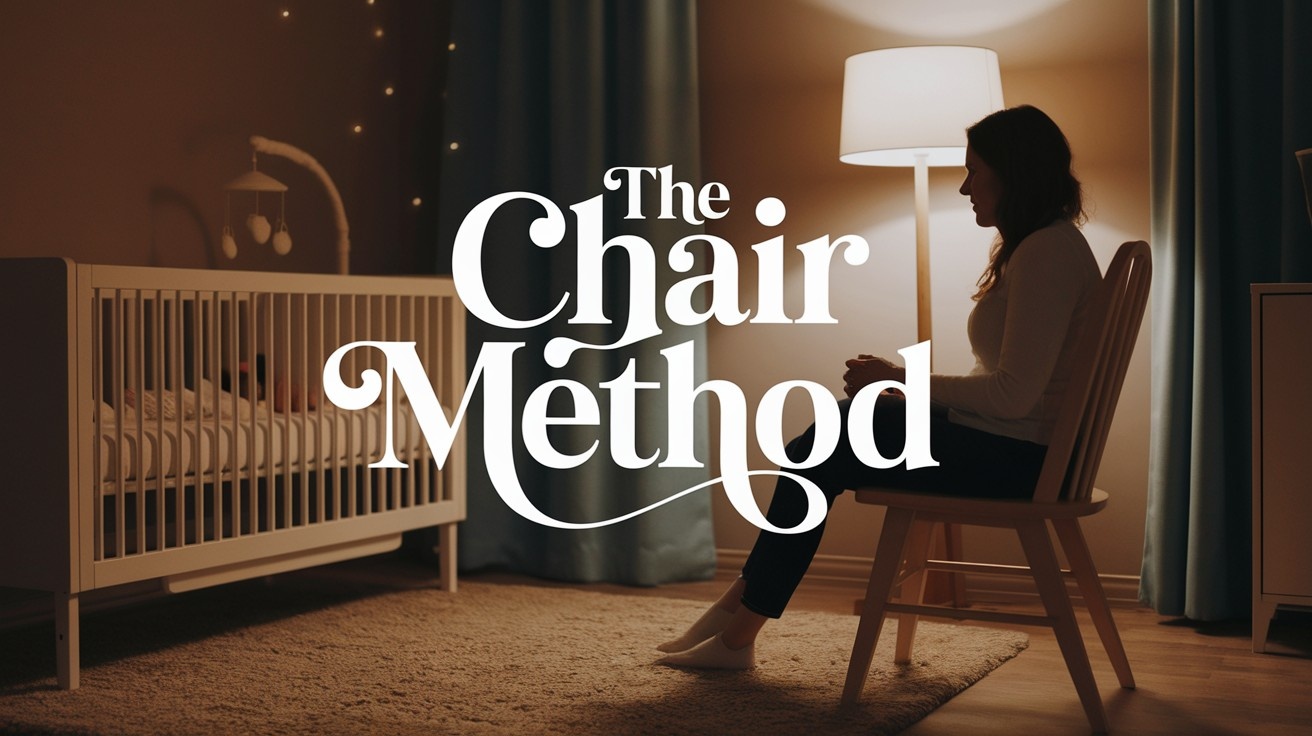
“Caught between midnight cuddles and desperate pleas for a full night’s sleep? The Chair Method might be your family’s sleep salvation.”
Sleep training helps babies learn to fall asleep independently, but many parents worry about methods that involve crying. Enter gentle sleep training approaches, which prioritize gradually reducing parental presence while offering emotional support.
The Chair Method (also called the Sleep Lady Shuffle or Camping Out) is a middle-ground solution.
Parents sit beside their baby’s crib, offering reassurance without picking them up, then gradually move the chair farther away over several nights until they’re eventually outside the room.
Studies show that gentle sleep training methods can be just as effective as traditional approaches but with significantly less stress for both parents and babies!
This gradual withdrawal technique allows babies to develop self-soothing skills while feeling secure that their parents haven’t abandoned them—making it perfect for families seeking a balanced approach to better sleep.
Chair Method Sleep Training
The Chair Method is a gentle sleep training approach for helping babies learn to fall asleep independently. Start by putting your baby in their crib while they’re drowsy but still awake.
When they cry, sit in a chair next to the crib to provide reassurance without picking them up. Each night, move the chair farther from the crib until you’re eventually outside the room.
This gradual approach helps your baby adjust to self-soothing while knowing you’re nearby. Most parents see progress within 1-2 weeks.
Key tips:
- Be consistent with bedtime routines
- Respond with minimal interaction when baby cries
- Move the chair a bit farther each night
- Stay calm and patient
- Expect some difficult nights at first
The Chair Method balances teaching independence while providing comfort during the transition.
Chair Method Sleep Training: Brief Overview

The Chair Method (also known as the Sleep Lady Shuffle) is a gentle sleep training approach where parents gradually move away from their baby’s crib over several nights.
How It Works?
Each night, you sit beside your baby’s crib in a chair until they fall asleep, offering verbal and minimal physical reassurance without picking them up. Every few nights, you move the chair farther from the crib until you’re eventually outside the room.
Typical First Nights
| NIGHTS | CHAIR POSITION | PARENTAL INVOLVEMENT |
|---|---|---|
| Nights 1–3 | Right next to the crib | Pat or shush the baby, but avoid eye contact |
| Nights 4–6 | Halfway between crib and door | Offer verbal comfort only |
| Nights 7–10 | By the doorway | Provide occasional verbal reassurance |
| Nights 11–14 | Outside the doorway | Gradually increase time away until baby falls asleep independently |
What Age Is Best for Chair Method Sleep Training?

Sleep training can be a challenging but rewarding trip for both parents and babies. The chair method, known for its gradual approach, can be particularly effective at certain developmental stages when your little one is ready for more independent sleep.
1. Recommended age range
The chair method is most effective for babies 6 months and older, when they’ve developed enough physical and emotional maturity to benefit from this gradual approach.
This gentle technique works particularly well for older babies and toddlers (9-18 months) who are more aware of your presence. Parents of children up to age 3 have also reported success with this method.
2. Signs your baby might be ready
Your baby may be ready for solids when it shows interest in your food, opens its mouth as food approaches, and can sit upright with little support. Look for doubled birth weight, loss of the tongue-thrust reflex, ability to move food backward in its mouth, hunger after full milk feeds, and good head control.
3. Age-specific adjustments to consider
Younger babies (6-9 months) need shorter intervals between chair movements, while toddlers (18+ months) require more verbal reassurance and explanation.
Adjust timing based on temperament—some children need gradual transitions regardless of age. Observe your child’s cues and reactions throughout the process. Be patient and flexible, allowing extra time when needed. Remember that each child progresses at their own pace.
Benefits of Chair Method Sleep Training
-
Provides a gentle, gradual approach to sleep training where parents slowly distance themselves from the crib over time
-
Builds trust and emotional security by maintaining a reassuring parental presence while babies learn to self-soothe
-
Reduces anxiety and guilt for parents compared to more abrupt “cry it out” methods, allowing the whole family to adjust at a comfortable pace
-
Fosters development of independent sleep skills while still offering nearby support and respecting the baby’s emotional needs
- Creates a balanced middle-ground option between co-sleeping and extinction methods, promoting sustainable sleep habits that improve overall family wellbeing
Common Challenges and How to Overcome Them
Parenting comes with inevitable hurdles, but with patience and the right strategies, you can guide them successfully.
Understanding these common challenges and having practical solutions at hand will help you maintain confidence through difficult moments.
1. Dealing with Setbacks or Regressions
Setbacks are a normal part of any developmental process. Remember that progress isn’t always linear, and temporary regressions often follow periods of rapid growth.
Stay patient and return to basics when needed, reinforcing the foundation before moving forward again.
2. What to Do if Your Baby Cries or Resists
Crying and resistance are your baby’s primary forms of communication. Respond calmly and consistently, acknowledging their feelings while maintaining boundaries.
Short breaks can help reset everyone’s emotions when tensions rise.
3. Staying Consistent Without Giving In
Consistency builds security and understanding. Create simple routines that work for your family’s lifestyle, and communicate expectations clearly.
Remember that self-care isn’t selfish—taking breaks when needed helps you maintain the consistency your baby needs.
Chair Method Sleep Training Success Tips
Creating a calming bedtime routine is essential for effective sleep training.
Start with a consistent 20-30 minute ritual, including a warm bath, gentle stories, and soft lullabies. Keep the room dimly lit and minimize stimulation.
For chair placement, position it initially close to the crib, where you can provide reassurance without direct contact. Gradually move the chair further away each night until you’re outside the room.
Choose a comfortable chair that allows you to remain present without falling asleep yourself. Track progress by keeping a simple sleep diary, noting bedtime, wake times, and interventions needed.
Remember that improvement isn’t linear—celebrate small victories like longer sleep stretches or fewer wake-ups.
Special tip: The “10-minute rule” can be the alternative—if your child is fussing but not truly distressed, wait 10 minutes before intervening. This small buffer often allows them to self-soothe naturally.
How Long Does Chair Method Sleep Training Take?

The chair method of sleep training typically takes 1-3 weeks to show meaningful results, though some parents report success in as little as 5-7 days.
This gradual approach involves parents sitting beside their child’s bed and progressively moving the chair farther away until they’re outside the room.
Several factors influence the duration and success rate. Your child’s age and temperament play significant roles—older babies and those with adaptable personalities often adjust more quickly.
Consistency is crucial; parents who maintain the routine nightly see faster results than those who implement it sporadically.
Environmental factors like room setup and daily routine stability can accelerate progress.
While challenging, most families complete the chair method within two weeks, and it produces lasting improvements in sleep quality and independence.
Sleep Training Methods Comparison
| METHOD | DESCRIPTION | PARENTAL INVOLVEMENT |
CRYING LEVEL |
TIMELINE |
|---|---|---|---|---|
| Chair Method | Parent sits beside crib, gradually moving further away each night until leaving room | High | Moderate | 1-3 weeks |
| Ferber Method | Progressive waiting approach with timed check-ins that increase each night | Moderate | Moderate to high | 5-7 days |
| Cry It Out | Full extinction method, where the parent puts the baby down and doesn’t return until morning | Low | High | 3-4 days |
| Pick Up/Put Down | Parent picks up crying baby to soothe, then puts down when calm but still awake | Very high | Low | 2-4 weeks |
Why families choose the Chair Method: Many parents select the Chair Method as a middle-ground approach that balances emotional comfort with sleep training effectiveness.
It provides reassurance through parental presence while still teaching self-soothing, making it ideal for parents who find cry-based methods too harsh but need more structure than no-cry approaches.
When to Consult a Pediatrician or Sleep Specialist
When to consult a pediatrician or sleep specialist about your child’s sleep issues depends on several warning signs.
Persistent sleep problems lasting weeks despite consistent routines, extreme daytime drowsiness despite adequate sleep time, unusual breathing patterns like snoring or gasping, and sudden behavioral changes accompanied by personality shifts or concentration difficulties all warrant professional attention.
While many sleep disruptions represent normal developmental phases, these red flags could indicate underlying medical conditions such as sleep apnea, respiratory issues, or developmental concerns requiring specialized evaluation.
Reaching out to healthcare providers promptly when these signs appear ensures proper diagnosis and targeted interventions that can significantly improve both your child’s sleep quality and overall well-being.
Final Words
Ready to reclaim peaceful nights? The Chair Method offers a balanced approach that respects both your baby’s need for security and your family’s need for sleep.
Remember: consistency is your greatest ally on this trip. The first few nights may challenge your resolve, but your gradual presence-reduction helps build your little one’s confidence.
How will you prepare for this transition? First, consider creating a soothing bedtime routine—perhaps a warm bath, a gentle story, and a soft lullaby.
Do you have questions about adapting this method to your unique situation? Share your concerns with your pediatrician or join online parenting communities where others have done the same.
The gift of independent sleep benefits everyone in your family. When will you begin your Chair Method experience? Your well-rested future awaits!
If you’re interested in more informational content on mothers and babies, feel free toclick here and explore other blogs that you might enjoy.
